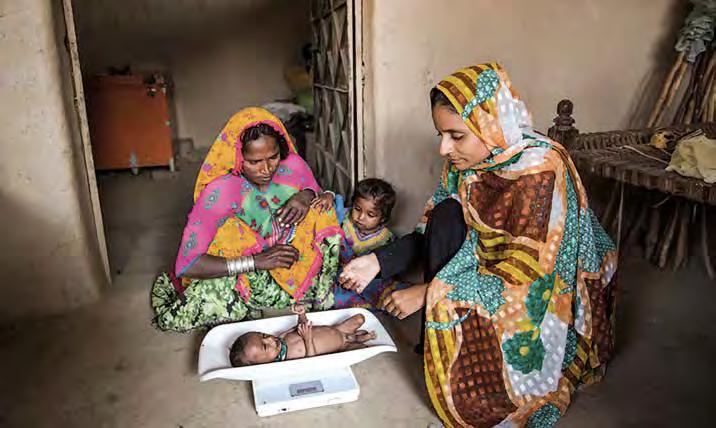
14 minute read
New Scientific Evidence on the Benefits of Maternal Multiple Micronutrient Supplements
from Sight and Life Special Report | Focusing on Multiple Micronutrient Supplementation in Pregnancy
Emily R Smith
Milken Institute School of Public Health, The George Washington University, Washington, DC, USA
Advertisement
Parul Christian
Bill & Melinda Gates Foundation, Seattle, WA, USA
Christopher R Sudfeld
Harvard T H Chan School of Public Health, Boston, MA, USA
Key messages
∙ Maternal nutrition is critical for the health and wellbeing of mothers and babies. Inadequate nutrition in pregnancy, including micronutrient deficiencies, can lead to health problems for mothers, can cause babies to be born too soon or too small, and increases the babies’ risk of death, poor health and suboptimal development. ∙ Multiple micronutrient supplements (MMS) – a combination of iron, folic acid and typically more than a dozen additional vitamins and minerals – addresses pregnant mothers’ special nutritional needs. ∙ Global evidence from high-quality, randomized trials demonstrates that daily supplementation with MMS in pregnancy compared with supplementation with iron and folic acid (IFA) alone improves birth outcomes. Two systematic reviews and meta-analyses show that MMS reduces the risk of babies being born with a low birth weight by 12–14 percent, reduces the risk of small-forgestational-age births by 3–8 percent and may reduce preterm birth by 5–7 percent. ∙ New analyses also show that MMS in pregnancy reduces the risk of mortality among female infants. All women and children were found to benefit, but the data suggests that MMS helps undernourished women especially. ∙ The evidence is clear: MMS is superior to IFA alone in supporting a positive pregnancy and a healthy infant.
Policymakers and program developers should take swift action to implement MMS: it is safe, it is cost-effective, it helps mothers and it gives babies a healthy start to life.
Maternal nutrition is critical for a healthy pregnancy
Nutrition in pregnancy is important for mothers’ health, as well as to support fetal growth and development. Inadequate diets – those without diversity of fruits and vegetables, animal-source foods and micronutrient-fortified foods – are common among pregnant women in low- and middle-income countries (LMICs). Such diets can lead to concurrent micronutrient deficiencies.1 In pregnancy, micronutrient deficiencies tend to be more common and more severe because pregnant women and their developing babies have elevated nutrient requirements.2 Studies estimate that roughly 38 percent of pregnant women in LMICs are anemic.3 And a recent review of survey data found that – among women of reproductive age in LMICs – 63.2 percent were vitamin-D-deficient, 41.4 percent were zinc-deficient, 22.7 percent were folate-deficient and 15.9 percent were vitamin-A-deficient.4
Micronutrient deficiencies in pregnancy can lead to health problems for mothers and cause babies to be born too small or too soon.5 In 2015, an estimated 20.5 million babies were born at low birth weight (< 2,500 g), and 91 percent of them were born in LMICs.6 That same year, roughly 15 million babies were born preterm (before 37 weeks of gestation), of which 80 percent were born in Asia and sub-Saharan Africa.7 Infants who are born low birth weight, preterm or small for gestational age (< 10th percentile of weight for their gestational age) are at increased risk of death.8 And low birth weight infants face an elevated risk for a host of other concerns, including stunting and suboptimal cognitive and motor development, as well as cardiovascular disease and other noncommunicable diseases in adulthood.9–11 Accordingly, supporting mothers’ nutrition in pregnancy, including adequate micronutrient intake, is critical to addressing the large burden and consequences that flow from low birth weight, small-for-gestational-age birth and prematurity in LMICs.
aidi Asad Z / © Bill & Melinda Gates Foundation
Dr Fayaz Umrani, research associate at Aga Khan University, checking a young boy during his field visit in Hussain Bhambro village, Matiari district, Sindh province, Pakistan, on 1 December 2016. The Sindh province is participating in the SEEM project, a study of environmental enteropathy and malnutrition sponsored by the Gates Foundation and Aga Khan University. Through the project, field officers calculate the weight-for-height z-scores (WHZ) of newborns in the province and monitor their progress. Enrolled cases are tracked on a weekly basis and nutritional supplements are given to combat malnutrition.
MMS can help address the high micronutrient demands of pregnancy. A commonly used MMS formulation is the United Nations International Multiple Micronutrient Antenatal Preparation (UNIMMAP). UNIMMAP is a once-daily supplement that was developed at an expert consultation hosted by UNICEF in 1999 to give pregnant women their Recommended Daily Allowance (RDA) or Adequate Intake (AI) of 15 essential vitamins and minerals. The UNIMMAP supplement includes iron and folic acid, vitamin A, vitamin D, vitamin E, thiamin, riboflavin, niacin, vitamin B12, vitamin B6, vitamin C, zinc, iodine, copper and selenium.
Randomized trials and the 2016 WHO Antenatal Care Recommendations
Over the past two decades, more than 20 randomized trials have examined the effects of MMS (including UNIMMAP) on maternal and infant health outcomes as compared with IFA alone. These trials included a total of over 140,000 women, and were conducted across the globe.
In 2016, the World Health Organization (WHO) reviewed the evidence on MMS as part of the development process for the Recommendations on Antenatal Care for a Positive Pregnancy Experience.12 At that time, the 2015 Cochrane Review – including 17 trials involving 137,791 women – was the primary source of summary evidence on the effects of MMS, showing that MMS reduced the risk of low birth weight, being born small for gestational age and stillbirth.13 Despite these beneficial effects, WHO did not universally recommend MMS, citing gaps in the evidence and concerns about potential risks associated with MMS. But the recommendations noted that “policy-makers in populations with a high prevalence of nutritional deficiencies might consider the benefits of MMN [multiple micronutrient] supplements on maternal health to outweigh the disadvantages, and may choose to give MMN supplements that include iron and folic acid.”12
Of note, the 2016 WHO Antenatal Care Guidelines did recommend other nutrition interventions including universal IFA supplementation, as well as calcium supplementation in contexts where calcium food intake is low.12 They also recommended nutritious food supplementation (i.e., balanced energy and protein supplements) in places where more than 20 percent of women of reproductive age are underweight (body mass index < 20 kg/m2).12
New evidence demonstrates clear benefits of MMS
Since the 2016 WHO Guidelines were released, additional research has confirmed that MMS reduces the risk of being born low

aidi Asad Z / © Bill & Melinda Gates Foundation
Fozia Arbab (right), research assistant at Aga Khan University, measuring the weight of severely malnourished 6-month-old Ghayan Chand during the field work in Hussain Bhambro village, Matiari district, Sindh province, Pakistan, on 1 December 2016

Zayada Jemal, health extension worker at Germama Health Post, preparing to measure the weight of Zebiba Yusuf’s 6-month-old baby, Moaz Behari, as Zebiba’s other children look on excitedly in Silte, Gurage Zone, Ethiopia, on 26 July 2016 aidi Asad Z / © Bill & Melinda Gates Foundation
birth weight and small for gestational age, and also revealed additional benefits for subgroups of mothers and infants. This new evidence includes new randomized trials, an individual patient data meta-analysis and an updated Cochrane Review, which are summarized below.
In response to the 2016 WHO Guidelines, investigators who had conducted randomized trials of MMS came together to investigate more systematically the efficacy and safety of MMS. More than 30 scientists from around the world collaborated on an ‘individual patient data meta-analysis,’ a method that is considered to be the gold standard for summarizing scientific evidence. The analysis included data from 17 randomized trials that analyzed data from 112,000 pregnant women in 14 countries (Burkina Faso, Ghana, Guinea-Bissau, Malawi, Niger, Tanzania, Zimbabwe, Mexico, Bangladesh, China, India, Indonesia, Nepal and Pakistan).14 Overall, this meta-analysis was consistent with the 2015 Cochrane Review; it found that MMS – as compared with IFA alone – improves birth outcomes. On average, the studies showed that MMS reduced the risk of: low birth weight by 14 percent, preterm birth by 7 percent, being born small for gestational age by 3 percent and stillbirth by 8 percent (see Figure 1).14 Furthermore, it found that MMS is especially beneficial for undernourished women. For example, women who were anemic or were too thin at the start of pregnancy saw even greater improvements in birth outcomes when taking MMS. The study also showed that the survival of baby girls improved when their mothers took MMS rather than IFA. Importantly, the meta-analysis did not find any evidence of increased risk of mortality or adverse birth outcomes related to MMS, and this was consistent across all subgroups of women (e.g., anemic versus non-anemic women, underweight versus non-underweight women). The meta-analysis therefore allayed the concerns offered by the 2016 WHO Guidelines regarding potential risks associated with MMS.
In March 2019, the Cochrane Review of MMS trials was revised.15 The updated version included data from three new trials and corrected minor errors that had appeared in the previous versions. Specifically, the study reviewed 20 randomized trials that compared MMS with iron supplements or iron with folic acid, and the trials captured data from 141,849 pregnant women. MMS was found to provide a robust and consistent 12 percent reduction in
figure 1: Two recent meta-analyses summarize data from high-quality randomized trials and show that MMS reduces the risk of babies being born too small (low birth weight or small for gestational age) or too soon (preterm)
0
Percent reduction in adverse birth outcome according to meta-analyses (%)
5
10
15
Low birth weight
Number of studies
17
18
Relative risk
(95% confidence interval)
0.86 (0.81 to 0.92) 0.88 (0.85 to 0.91)
12%
14%
Source: Smith et al. 201714 / Keats et al. 201915
Preterm
Number of studies Relative risk
(95% confidence interval)
16
0.93 (0.87 to 0.98) 18 0.95 (0.90 to 1.01)
7% 5%
Small for gestational age
Number of studies
16
17
Relative risk
(95% confidence interval)
0.97 (0.96 to 0.99) 0.92 (0.88 to 0.97)
3%
8%
Percent reduction from Smith et al. 2017 meta-analysis14 Percent reduction from Keats et al. 2019 meta-analysis15

aidi Asad Z / © Bill & Melinda Gates Foundation
A group of Agogos (meaning ‘grandparents’) help a mother bring home her newborn baby from Ekwendeni Mission Hospital, in the Mzimba district, Malawi. Agogos are a community group that have been trained through Ekwendeni Mission Hospital to advise pregnant women on proper health practices during pregnancy. They encourage women to get early antenatal care and to arrange for delivery to take place at a health center or hospital.
the risk of having a baby with a low birth weight and an 8 percent reduction in the risk of having a small-for-gestational-age baby (see Figure 1). The authors also concluded that MMS probably reduced the risk of preterm birth by about 5 percent.
In order to synthesize and interpret the new evidence for policymakers and healthcare providers, the New York Academy of Sciences convened a Multiple Micronutrient Supplementation in Pregnancy Task Force. The Task Force consisted of nutrition and maternal health experts, scientists researching micronutrients in pregnancy, donors, key development partners and interested country-level decision-makers. The Task Force took on four areas of work: (a) it conducted additional analyses to quantify the benefits of MMS and to check for any associated risks; (b) it characterized the contexts where adoption of MMS would be warranted based upon mothers’ diets, prevalence of deficiencies, available healthcare services, costs and cost-effectiveness; (c) it explored the practical considerations of MMS introduction, such as procurement and promotion; and (d) it developed an information-sharing strategy regarding the introduction and use of MMS. The Task Force recently released its findings in a special issue on MMS in the Annals of the New York Academy of Sciences.4,16–18 This work concluded that the use of a daily MMS is overall beneficial, does not increase the risk of adverse effects or result in excess micronutrient intake, has a number of additional benefits for mortality reduction and birth outcomes compared with IFA,4 and can be a cost-effective intervention for pregnant women in LMICs.14
Ongoing evidence efforts
Following this first phase of work, a subgroup of the Task Force now serves as a Technical Advisory Group (TAG) to support the growing momentum and interest in the distribution of MMS by NGOs, funders and governments. The TAG will support efforts by providing information, coordination services and advice regarding the introduction of MMS in various contexts. Specifically, the TAG will: (a) be a coordinating body for groups seeking to promote or fund the distribution of MMS; (b) provide ongoing technical guidance regarding all things related to MMS; (c) provide partners with technical briefs, roadmaps for introduction in countries and other documents as needed; and (d) organize collaborative efforts to share work and information.
The TAG held its first meeting in February 2019, and it developed a website to serve as an up-to-date resource. In addition, the TAG conducted a Child Health and Nutrition Research Initiative
exercise to identify priority research questions related to MMS; that effort was recently published.19 The TAG is currently conducting a systematic review of barriers to, and enablers of, adherence to an MMS regimen in pregnancy. The TAG, together with the Micronutrient Forum, has co-organized a workshop to develop a global MMS product specification for manufacturers; the meeting was held in Washington, DC, in November 2019.
A call to action
The scientific evidence is clear: MMS is superior to IFA to give women and their babies a positive pregnancy experience and healthy start to life. Making the switch from IFA alone to comprehensive MMS is a solution that is readily available to be delivered at scale through established delivery channels for supplements in pregnancy. The global community must move swiftly from evidence to action to support healthy mothers and babies.
Correspondence: Emily R Smith, Milken Institute School of Public Health, The George Washington University, 950 New Hampshire Ave, NW – Room 406, Washington, DC 20052, USA Email: EmilySmith@gwu.edu
References
1 Jiang T, Christian P, Khatry SK, Wu L, West KP, Jr. Micronutrient deficiencies in early pregnancy are common, concurrent, and vary by season among rural Nepali pregnant women. J Nutr. 2005;135(5):1106–12. 2 King JC. Physiology of pregnancy and nutrient metabolism.
Am J Clin Nutr. 2000;71(5 Suppl):1218S–25S. 3 Stevens GA, Finucane MM, De-Regil LM, Paciorek CJ, Flaxman SR,
Branca F, et al. Global, regional, and national trends in haemoglobin concentration and prevalence of total and severe anaemia in children and pregnant and non-pregnant women for 1995–2011: a systematic analysis of population-representative data. Lancet Glob
Health. 2013;1(1):e16–25. 4 Bourassa MW, Osendarp SJM, Adu-Afarwuah S, Ahmed S,
Ajello C, Bergeron G, et al. Review of the evidence regarding the use of antenatal multiple micronutrient supplementation in low- and middle-income countries. Ann N Y Acad Sci. 2019;1444(1):6–21. 5 Black RE. Micronutrients in pregnancy. Br J Nutr. 2001;85 Suppl 2:S193–7. 6 Blencowe H, Krasevec J, de Onis M, Black RE, An X, Stevens GA, et al. National, regional, and worldwide estimates of low birthweight in 2015, with trends from 2000: a systematic analysis. Lancet Glob
Health. 2019;7(7):e849–e860. 7 Chawanpaiboon S, Vogel JP, Moller AB, Lumbiganon P, Petzold M,
Hogan D, et al. Global, regional, and national estimates of levels of preterm birth in 2014: a systematic review and modelling analysis.
Lancet Glob Health. 2019;7(1):e37–e46. 8 Katz J, Lee AC, Kozuki N, Lawn JE, Cousens S, Blencowe H, et al.
Mortality risk in preterm and small-for-gestational-age infants in low-income and middle-income countries: a pooled country analysis.
Lancet. 2013;382(9890):417–25. 9 Christian P, Lee SE, Donahue Angel M, Adair LS, Arifeen SE, Ashorn P, et al. Risk of childhood undernutrition related to small-for-gestational age and preterm birth in low- and middle-income countries. Int J
Epidemiol. 2013;42(5):1340–55. 10 Fall CH. Fetal malnutrition and long-term outcomes. Nestlé Nutr Inst
Workshop Ser. 2013;74:11–25. 11 Sania A, Sudfeld CR, Danaei G, Fink G, McCoy DC, Zhu Z, et al. Early life risk factors of motor, cognitive and language development: a pooled analysis of studies from low/middle-income countries. BMJ
Open. 2019;9(10):e026449. 12 World Health Organiziation. WHO Recommendations on Antenatal
Care for a Positive Pregnancy Experience. WHO Guidelines Approved by the Guidelines Review Committee. Geneva: WHO; 2016. 13 Haider BA, Bhutta ZA. Multiple-micronutrient supplementation for women during pregnancy. Cochrane Database Syst Rev. 2015(11):CD004905. 14 Smith ER, Shankar AH, Wu LS, Aboud S, Adu-Afarwuah S,
Ali H, et al. Modifiers of the effect of maternal multiple micronutrient supplementation on stillbirth, birth outcomes, and infant mortality: a meta-analysis of individual patient data from 17 randomised trials in low-income and middle-income countries. Lancet Glob Health. 2017;5(11):e1090–e1100. 15 Keats EC, Haider BA, Tam E, Bhutta ZA. Multiple-micronutrient supplementation for women during pregnancy. Cochrane Database
Syst Rev. 2019;3:CD004905. 16 Black RE, Dewey KG. Benefits of supplementation with multiple micronutrients in pregnancy. Ann N Y Acad Sci. 2019;1444(1):3–5. 17 Engle-Stone R, Kumordzie SM, Meinzen-Dick L, Vosti SA. Replacing iron-folic acid with multiple micronutrient supplements among pregnant women in Bangladesh and Burkina Faso: costs, impacts, and cost-effectiveness. Ann N Y Acad Sci. 2019;1444(1):35–51. 18 Gernand AD. The upper level: examining the risk of excess micronutrient intake in pregnancy from antenatal supplements.
Ann N Y Acad Sci. 2019;1444(1):22–34. 19 Gomes F, Bourassa MW, Adu-Afarwuah S, Ajello C, Bhutta ZA,
Black R, et al. Setting research priorities on multiple micronutrient supplementation in pregnancy. Ann NY Acad Sci. 2020
Apr;1465(1):76–88.










